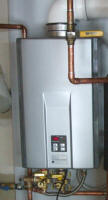 I
had been considering replacing our relatively efficient propane fired
water heater tank with a
tankless model when opportunity knocked in the
form of a major leak in our 10 year old tank. I
had been considering replacing our relatively efficient propane fired
water heater tank with a
tankless model when opportunity knocked in the
form of a major leak in our 10 year old tank.
Tankless - or demand heaters have been used in Europe for over 20 years,
and in China they are the predominant style in use partly because they
take up less space in their smaller homes. Perversely tank type
heaters cost more and are installed only by the wealthy in China.
In the US tankless heaters cost several times a tank type - go figure!
The advantage of a demand heater is that there is no standby loss.
Tanks are always leaking heat that needs replenishing whether you are
using it or not. This is why it is a good idea to turn a tank
heater off when you leave the home for extended periods. The
energy required to keep the tank warm is significant, especially if the
tank is in an unheated part of the home, like the basement. Demand
heaters only use energy when hot water is needed. |
 My
first call - after shutting off the water - was to my friend
Bob Hardina
(right),
who was the original owner of
Mid-Coast Energy Systems Inc. in Damariscotta,
Maine. Bob is an
energy efficiency guru and has been committed to energy efficient homes
since the 1970's. His knowledge of home heating systems is
encyclopedic! Since I had not had the time to research the optimal
demand heater for my application, I knew that I could trust Bob to
specify one that would work well for our needs. Bob is one of the
hardest working "retired" guys I know! My
first call - after shutting off the water - was to my friend
Bob Hardina
(right),
who was the original owner of
Mid-Coast Energy Systems Inc. in Damariscotta,
Maine. Bob is an
energy efficiency guru and has been committed to energy efficient homes
since the 1970's. His knowledge of home heating systems is
encyclopedic! Since I had not had the time to research the optimal
demand heater for my application, I knew that I could trust Bob to
specify one that would work well for our needs. Bob is one of the
hardest working "retired" guys I know!
Bob and the staff of Midcoast really came through in this emergency. David from Midcoast came out to review the site and spec all the parts needed that
very afternoon only a few hours after my frantic phone call.
Bob had already specified a
Rinnai R75LSi
propane heater,
this unit
retails for about $900-1200
(in 2010). It has a capacity to produce .6 to 7.5 gpm at a 45F
temperature rise and is 84% efficient. Standby electric power is
about 2 Watts and when operating it draws around 65 Watts. The
direct vent design means that it burns outside air, and it is
Energy Star rated so it qualifies for a 30% tax credit of up to
$1500 of the installed cost in 2010.
Here's a good review site for tankless water heaters:
https://www.reviews.com/tankless-water-heater/ so you can make your
own informed decision.
This unit needs a minimum differential temperature of 40F, so I
considered adding a temperature mixing valve between my
solar tank and the Rinnai, but my
solar tank rarely exceeds 100F so I'm not going to bother with that.
If you have a higher performing solar water heater then I recommend a
mixing valve to limit the incoming temperature to the tankless unit.
Different tankless models have different input requirements, and none of
them seem to mention or even encourage solar pre-heat tanks.
Nonetheless they can be used that way with caution, check with the
manufacturer or an experienced plumber before purchasing a tankless unit
to work with solar pre-heated water.
Our installed cost was
over $2600 so we will get a nice tax break.
The
federal tax incentive valid through December 30, 2010 allows us to take 30% of the
installed cost (includes labor) of the
system off our federal taxes - up to $1500. Hopefully this program
will be renewed. Here's the approximate price breakdown:
| Rinnai water heater |
$1090 |
| labor |
$600 |
| Plumbing parts |
$910 |
| Total |
$2600 |
| 30% federal tax beak (max $1500) |
-$858 |
| Efficiency Maine rebate |
-100 |
| Net cost |
$1642 |
|
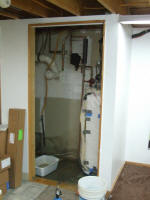 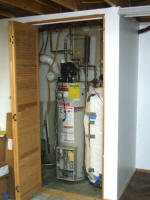
I spent much of the day cleaning up the water damage and removing the
old water heater and preparing the site by adding a 2X4 ft. mounting board
of painted 3/4" plywood for the new heater. It was my plan to help as much
as I could to get the job prepared and to assist in the installation by
working with the Midcoast plumber the following day. |
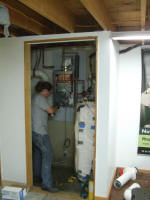 The
next morning David returned with Caitlin the plumber (at left) and they
walked through the job with me. On closer inspection David
determined that the propane lines in place were not big enough to service the
high demand of the Rinnai. It requires a maximum of 180,000 Btu/h
to operate. So we had to run a new line of 1" flexible pipe to the
propane tanks - a run of over 40 feet. This is a significant issue
when installing these units, they need a much higher flow of gas than
tank style heaters. (The same is true of the electric demand
heaters, and a new feed line needs to be run directly to provide enough
energy). The
next morning David returned with Caitlin the plumber (at left) and they
walked through the job with me. On closer inspection David
determined that the propane lines in place were not big enough to service the
high demand of the Rinnai. It requires a maximum of 180,000 Btu/h
to operate. So we had to run a new line of 1" flexible pipe to the
propane tanks - a run of over 40 feet. This is a significant issue
when installing these units, they need a much higher flow of gas than
tank style heaters. (The same is true of the electric demand
heaters, and a new feed line needs to be run directly to provide enough
energy).
Additionally my self installed solar
heating system plumbing needed to be moved around a bit to make room
for the new heater. Caitlin got to work right away doing a really
neat job of tidying up my plumbing and connecting the Rinnai's water and
gas lines. |
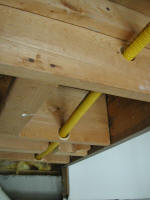 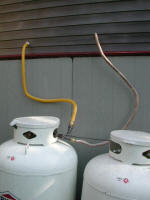
While Caitlin got to work installing the Rinnai - I used Midcoast's
powerful right angle drill and bored 1.5" holes through the ceiling
beams and pulled the 1" pipe through and secured it all to the beams and
on through the outside wall. I left plenty of extra at both
ends for the connections. I sealed the exit holes with
Great Stuff
spray foam when the job was done. |
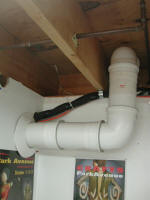 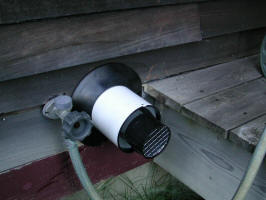 I
also cut out the interior and exterior walls to make room for the larger
vent pipe. The original unit had a 3" PVC forced vent to remove
fumes. The Rinnai is closed combustion device that uses outside
air for combustion and the larger duct has an inner concentric exhaust
tube, surrounded by the incoming air portion. The big vent exits
right next to our front porch. I
also cut out the interior and exterior walls to make room for the larger
vent pipe. The original unit had a 3" PVC forced vent to remove
fumes. The Rinnai is closed combustion device that uses outside
air for combustion and the larger duct has an inner concentric exhaust
tube, surrounded by the incoming air portion. The big vent exits
right next to our front porch.
The vent pipe had to be installed such that the condensate that forms
inside would run back down to the Rinnai where a flexible hose draws it
off to a drain bucket on the floor. The outer section was sloped down
toward the outside so that would just drain outside. I learned that
managing condensate requires some thought and planning.
One benefit of the new unit is that the old vent had a very noisy blower
on it that was loud enough to be quite annoying for Rebekah in her work
space. It was loud enough to hinder normal conversation. The
Rinnai's internal blowers are so quiet you barely notice them. |
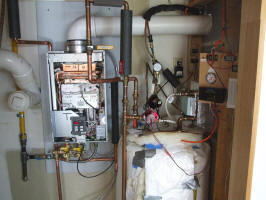 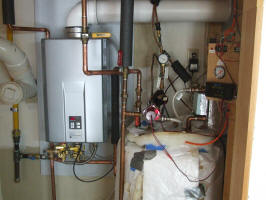
Here is the Rinnai installed with cover off and on. You can see
Caitlin's very clean work in the left side of the pictures.
Hopefully this unit will reduce our reliance of fossil fuel propane
somewhat. |
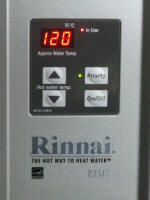
After a full day's work we purged the gas and water lines and plugged in
the Rinnai. I ran some water in the sink and moments later - hot
water at last!
Caitlin had very kindly stayed late to complete the job, she did not
want to leave it unfinished and likes to get it done right. She
was just as obsessed as I would be on the job - I can totally relate!
After I helped her pack up, I ran upstairs to take my first shower, it
was WONDERUL! Did I mention that the day was very hot and
humid and it had rained most of the day? I was really ready for
that shower! |
|
Becky and I are noticing that it does now take longer for the
water to arrive when we open the faucet. The Rinnai takes a few
seconds to get going and heat up the whole manifold. Fortunately I
had installed a D'Mand water saver in the 2nd floor bathroom which has the longest
plumbing run (about 35 feet). So we can push a button and wait a
minute or so for the hot water to get pulled up to the bathroom without
having to waste water running it until it gets hot.
Learn more about the
D'Mand pump here. |
|
After living with the tankless heater for a few weeks we have come
to learn about the small lifestyle changes we need to make to adjust
to using this type of water heater. I have read many reviews
of tankless heaters in which people complain that they don't work
properly and you get cold water at unexpected times. Well, I
think that this is due to their lack of understanding of how a
tankless water heater operates. If you are running hot water
and shut it off for more than a few seconds, the heater will shut
off. Then when you re-open the hot faucet the heater needs to
re-start and during the start-up cold water is flowing through it
and you will get a brief burst of cold - or cooler water. So
the strategy is to maintain a flow. The Rinnai requires a
minimum of .5 gallons/minute to operate or it will shut down.
So when rinsing dishes it's best to keep the water running rather
than start-stop cycling the hot.
|
Being a geek I wanted to quantify the difference in hot water
delivery between a tankless and tank type heater. So I ran tests
on my heater from the kitchen faucet that is right above the heater -
about 6 feet of pipe run. Here's the result of that test:
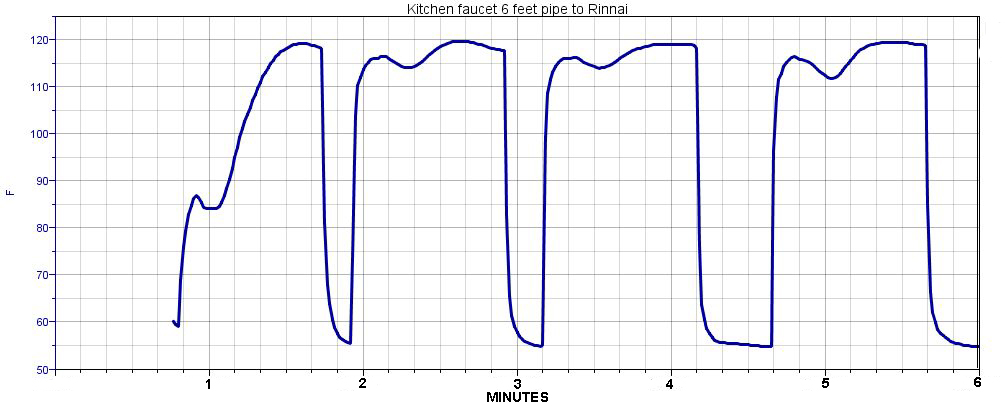
As you can see I ran hot water for 1 minute periods separated by periods
of 10, 15 and 30 seconds where I switched to cold. In changing to
cold - the hot was completely off and I used the cold water to chill
down the temperature sensor which has a 15 second time constant.
So the sensor responds slower than the water temperature change which
was effectively instantaneous.
What the plot shows is that it takes about 45 seconds to deliver hot
water, and that even stopping the water for as little as 10 seconds will
produce a burst of colder water. I suspect that if my sensor could
respond faster that the dips would actually drop down to about 100F.
This is not really cold - but is noticeably cooler to the touch.
Notice that the dips become more pronounced the longer the hot water is
shut off.
|
Then I went over to my neighbor's house that has a traditional 40
gallon tank type water heater with about 10 feet of plumbing to the
closest faucet, and ran the same test. Here the hot water takes
about the same time to arrive, but shutting off and re-starting the hot
flow has no real effect on delivered temperature. (Note that when I
switched to cold - the pipes were originally at ambient temperature -
about 70F, and it took a while for the cold line to chill down, so that
explains the cold dips becoming progressively colder.)

So clearly tankless water heaters require a change in usage
strategy in order to prevent unexpected temperature dips! It's not a
design failure it's a failure of the humans who refuse to adapt.
Learning to live with a tankless heater is like learning to drive a
hybrid vehicle. If you don't change your habits you will suffer -
either with cold water - or with poor gas mileage! I have seen
people who have bought a Toyota Prius and have gotten very poor MPG
simply because they refused to learn how it works and how to change
their driving style to optimize it's performance. I call this the
"Lazy American Syndrome". We have become so accustomed to
unlimited cheap resources that we have we forget how to think frugally. |













